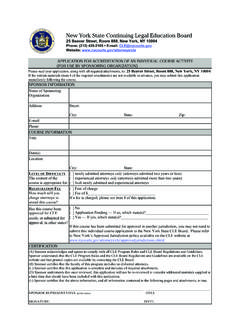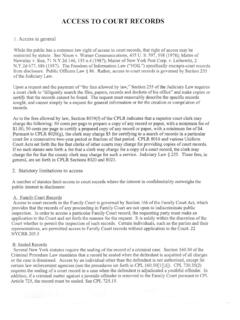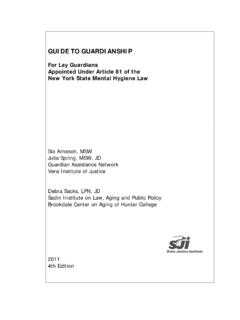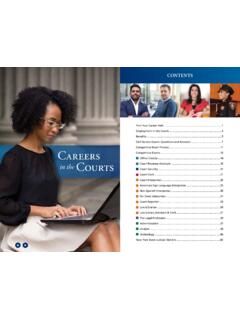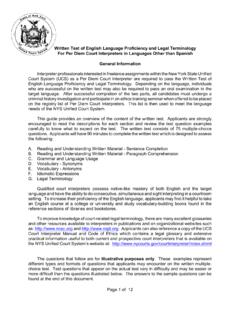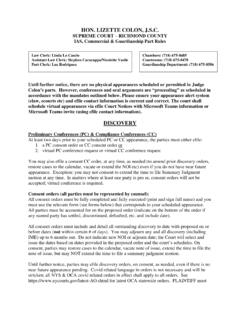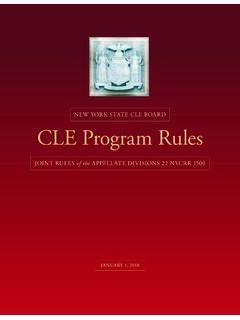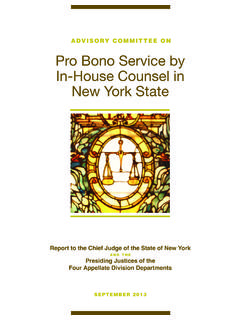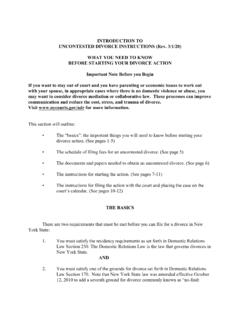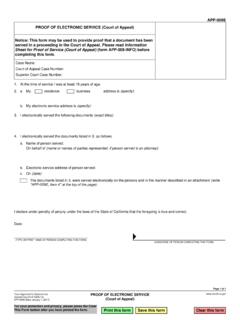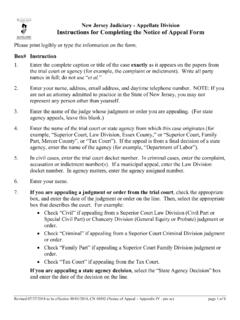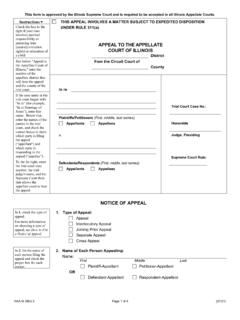Transcription of NEW YORK STATE UNIFIED COURT SYSTEM NEW YORK …
1 Janet DiFioreChief Judge of the COURT of Appeals and the STATE of New YorkLawrence K. MarksChief Administrative Judge of the STATE of New YorkJULY 2016 NEW YORK STATE COURTSAN INTRODUCTORY GUIDENEW YORK STATE UNIFIED COURT SYSTEM Both the federal government and each of the 50 states have their own COURT systems. The Constitution and laws of each STATE establish the STATE courts. The New York STATE UNIFIED COURT SYSTEM is made up of various levels of trial and appellate courts; the highest COURT is the COURT of legal issues are resolved in our STATE courts. New York s STATE COURT SYSTEM handles nearly four million cases a year, heard throughout the STATE s 62 counties. Matters brought before the STATE s judges, hearing officers, support magistrates and attorney-referees span the gamut from criminal cases to personal injury claims to commercial disputes to landlord-tenant issues.
2 Sometimes, we may overlook the fact that the STATE s Judiciary along with our Executive and Legislative branches is a co-equal partner in government that, in many ways, can have a significant impact on our daily structure of the New York STATE UNIFIED COURT SYSTEM can seem as complex as it is vast. This guide provides an easy-to-understand overview of the courts and also includes information about important resources and services. I encourage you to familiarize yourself with the workings of our courts and hope you find this guide a helpful reference tool. Sincerely, Janet DiFiore Chief Judge of the COURT of Appeals and the STATE of New YorkA MESSAGE FROM THE CHIEF JUDGECOURT AUTHORITY AND STRUCTURE.
3 1 The Trial Courts ..1 Trial Courts Operating In And Outside New York City ..2 Appellate Courts ..3 RESOURCES AND SERVICES FOR THE PUBLIC ..4 Help for Those Without a Lawyer ..4 Accommodations for Those with Disabilities ..5 Alternative Dispute Resolution (ADR) Programs (Mediation, etc.) ..5 Assigned Counsel Program ..5 Attorney Directory ..5 Attorney Disciplinary Program ..6 Attorney for the Child Program ..6 Case Information and Tracking ..6 Children s Centers ..6 Comments, Suggestions or Filing a Complaint ..7 County Clerks Offices ..7 COURT Interpreting Services ..8 Criminal History Search ..8 Divorce Resources ..8 Domestic Violence Resources ..9 Fiduciaries ..9 Juror Web Site and Hotline ..9 Lay Guardian Assistance Program.
4 9 Legal Research Assistance for the Public ..10 Parent Education and Awareness Program ..10 DIRECTORY OF ADMINISTRATIVE OFFICES ..11 Courts In New York City ..11 Courts Outside New York City ..13 Statewide ..15 HERE ARE SOME HELPFUL FEATURES YOU LL FIND ON OUR WEB SITE: ..16 1-800- COURT -NY 1 COURT AUTHORITY AND STRUCTUREC ases start in the trial courts. Though most cases are decided at the trial- COURT level, parties will occasionally ask a higher COURT to reconsider the case (an appeal ). Most appeals are first heard in the intermediate appellate courts, which review the decisions of lower courts to make certain that the law was properly applied. In New York, the highest COURT is the COURT of Appeals. Listed here are brief descriptions of the various trial and appellate courts that make up the New York STATE COURT TRIAL COURTSIN NEW YORK CITYThe Civil COURT of the City of New York decides lawsuits involving claims for damages up to $25,000 and includes a small claims part for cases involving amounts up to $5,000 as well as a housing part for landlord-tenant Criminal COURT of the City of New York handles misdemeanors (crimes punishable by fine or imprisonment of up to one year) and lesser offenses.
5 Criminal COURT judges also conduct arraignments (initial COURT appearances following arrest) and preliminary hearings for felonies (crimes punishable by imprisonment of more than one year).OUTSIDE NEW YORK CITYD istrict Courts, located in Nassau County and the five western towns of Suffolk County, arraign defendants accused of felonies and handle misdemeanors and lesser offenses as well as civil suits involving claims up to $15,000. City Courts arraign defendants accused of felonies and handle misdemeanors and lesser offenses as well as civil suits involving claims up to $15,000. Some City Courts have small claims parts, 2 THE NEW YORK STATE COURTS AN INTRODUCTORY GUIDE where matters involving claims up to $5,000 are handled, and/or housing parts, which handle landlord-tenant matters.
6 Town and Village Justice Courts handle misdemeanors and lesser offenses. Although the County Courts try felony cases, town and village justices first arraign defendants in Town and Village Courts. Town and Village Courts also hear civil suits involving claims up to $3, Courts, located in each county outside New York City, have exclusive authority to conduct trials in felony matters, while sharing authority with local City and Town and Village Courts to handle trials in misdemeanor cases and other minor offenses. County Courts also have limited authority over cases involving claims for money damages up to $25, COURTS OPERATING IN AND OUTSIDE NEW YORK CITYThe Supreme COURT generally hears cases outside the authority of the lower courts, such as civil matters involving higher dollar amounts; divorce, separation and annulment proceedings; and criminal prosecutions of felonies.
7 (Outside New York City, Supreme Courts hear civil matters while the County Courts hear criminal matters.) The Family COURT hears matters involving children and families including adoption; guardianship; foster care approval and review; juvenile delinquency; family violence; child abuse and neglect; and child support, custody and visitation. The Surrogate s COURT hears cases relating to individuals who have passed away, including the validity of wills and the administration of estates. These courts are also authorized to handle COURT of Claims has exclusive authority over lawsuits seeking money damages against the STATE of New York. The COURT of Claims 1-800- COURT -NY 3also has jurisdiction over lawsuits seeking money damages against certain STATE -related entities such as the New York STATE Thruway, the City University of New York and the New York STATE Power Authority (for claims related to the taking of real estate only).
8 APPELLATE COURTSINTERMEDIATE APPELLATE COURTSA ppellate Terms of the Supreme COURT in the First and Second Departments* hear appeals of decisions in cases starting in the New York City Civil and Criminal Courts. In the Second Department, the Appellate Terms also hear appeals of decisions in cases that started in the District, City or Town and Village Courts. The County Courts in the Third and Fourth Departments, while primarily trial courts, hear appeals of decisions in cases starting in the City Courts and Town and Village Courts. There are four Appellate Divisions of the Supreme COURT , one in each judicial department.* The Appellate Divisions hear civil and criminal appeals from the trial courts as well as civil appeals from the Appellate Terms and County Courts.
9 HIGHEST APPELLATE COURTThe COURT of Appeals, New York s highest COURT , hears civil and criminal appeals from the STATE s intermediate appellate courts, and in some instances from the trial courts. The COURT of Appeals also hears appeals of decisions reached by the STATE Commission on Judicial Conduct, which is responsible for reviewing allegations of misconduct brought against judges. In addition, the COURT of Appeals makes rules governing the admission of attorneys to the New York STATE bar.* For administrative purposes, the COURT SYSTEM is divided geographically into four judicial departments and 13 judicial districts. The First Judicial Department includes districts 1 and 12; the Second Judicial Department, districts 2, 9, 10, 11 and 13; the Third Judicial Department, districts 3, 4 and 6; and the Fourth Judicial Department, districts 5, 7 and 8.
10 * See directory on pages 11 15 for a list of counties comprising each THE NEW YORK STATE COURTS AN INTRODUCTORY GUIDERESOURCES AND SERVICES FOR THE PUBLICHELP FOR THOSE WITHOUT A LAWYER COURTHELP: ONLINE ASSISTANCEA website designed to help New Yorkers who do not have attor-neys navigate the COURT SYSTEM , CourtHelp, , has information on COURT procedures, COURT locations, law librar-ies, legal research sites and lawyer referral services. Visitors to the site can also download free COURT HELP CENTERSMany courts in New York STATE have help centers located right at the courthouse to assist people who do not have a lawyer. These offices are staffed by clerks and COURT attorneys who pro-vide free legal and procedural information, offer referrals and provide free COURT forms and publications.
